How to choose a hand plane?

A hand plane is a special tool designed for processing wooden surfaces of various elements and structures. The planer is used by carpenters and joiners, as well as lovers of woodworking.
Through the work of the plane, it is possible to give the wooden surface the required shape and achieve straight lines and the desired parameters. The tool will improve the appearance of the processed material.


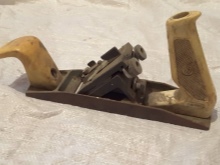
Features and purpose
Consideration of a unique woodworking machine should start with its features. Plane used for planing wood, namely: to give a wooden surface to the desired shape. In the process of operation, the plane removes various irregularities and roughness, as well as eliminates the surface of the material from defects that can spoil the attractive appearance of the element, selects a quarter.
The key feature of planers is the possibility of their use by both professional craftsmen and inexperienced people who urgently need to process a wooden surface. And also some models contain a sampler.
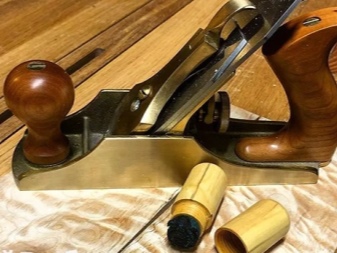

What does it consist of?
The plane device involves the use of several elements in the structure. Everyone should get to know better.
- Cutter. The basis of the tool. It is a rectangular plate with a pointed end. The cutter is installed in the opening of the block, observing a certain angle to organize better cutting. Additionally, an adjusting mechanism is provided to adjust the position of the knife. It allows you to set the blade to the required distance. By means of a correctly calibrated distance, it is possible to adjust the depth of cut and the thickness of the chips removed from the material. According to the standards, the knife has a certain sharpening angle. However, in the case of using a planer by craftsmen, a specialist can independently process the surface of the cutter.
- Lever. An equally important element of the scheme. It is worth noting that the hand plane contains two handles. One is used to guide the tool, and the other is made to stop. The first has a more curved design, which allows for a secure grip of the tool. The thrust handle provides an opportunity to create the necessary force during the surface treatment of the material.
- Frame. It features a smooth surface in which the cutter is located. The bottom part of the body is perfectly flat, which ensures high-quality glide of the planer on the wood surface and does not deform the material being processed. For the manufacture of the case, steel or wood materials are used. The first option is more popular. The masters argue that it is easier to work with a steel plane. Joiners choose metal aggregates, which use gray cast iron as the material for the creation.



Today, over 10 varieties of hand planers are known. Manufacturers regularly improve the design of the tool and release new modifications.
Therefore, the typical design of a hand planer is not a hindrance to the emergence of a large number of models.
Tool types
Planers have several classifications. If we consider their division into types, then there are tools for processing the following types:
- finishing;
- curly;
- rough or rough.
The latter are used for general purposes and are suitable for unskilled craftsmen. Finishing, in turn, implies the division of planers into several modifications.
- Grinder. With this tool, the final finish of the tree is carried out. The plane copes well with irregularities and defects, eliminating them from the surface, noticing even small elements left after processing with the previous tool. The design of the grinder contains two blades of increased sharpness. The knife sharpening angle does not fall below 60 degrees. A chipbreaker is also provided - a plate located above the cutting blade.
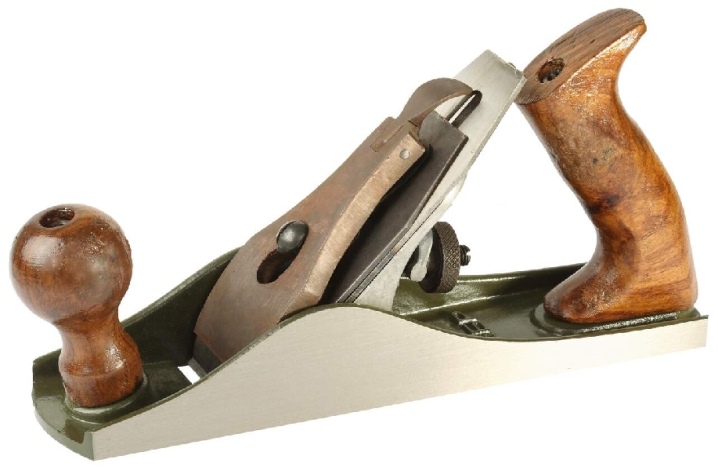
- Tsinubel. A device that gives a surface a decorative roughness. It somewhat resembles a dirt surface and has the advantage of improving grip. With this treatment, varnish is applied to wood quickly and is easily absorbed. The incisors of the tool are sharp, grooves are provided on their surface. And also the design of the zinubel includes knives with a blade, at the end of which there are notches.

- Miter plane. The tool is used in the case of processing small surfaces - mainly end surfaces. Actually, this is what the name says.


- Single. Designed for repeated penetration on the surface of a tree. By working with this tool, it is possible to get clean chips without kinks, however, during use, chips and scuffs appear on the tree. Therefore, it is used in conjunction with a grinder.

- Double plane. The design of the tool is equipped with a cutter and a chip breaker, which improves the quality of processing. However, even in this case, additional penetration with a sander on the wooden surface will be required.

When the need arises for finishing, preference is given to the listed tools. Such planers are also called devices for flat planing.
It is noteworthy that after their use, the surface of the material is additionally polished using sandpaper.


Rating of the best models
Today, manufacturers produce a huge number of hand planers of a wide variety of designs and designs. So that your eyes do not run up when buying, it is worth bringing the top 5 popular models of planers, with the help of which it will be possible to qualitatively process a wooden surface.
Stanley 1-12-034
A popular model that is actively used on construction sites. The company has been manufacturing working processing tools for over 170 years, so there is no doubt about the quality of the equipment.
The plane copes with the task perfectly. It can be used to treat the surface of all types of wood, including hard woods. TOThe design of the tool provides for the installation of a special mechanism. With its help, it is possible to achieve precise adjustment of the angle of the blade, which allows you to quickly solve a specific task.
Pros of the model:
- robust construction;
- long service life;
- cast and comfortable tool handles.
The plane is literally made for comfortable work.

Pinie 51 mm
The peculiarity of the model is the use of first-class wood species in the manufacture of a plane. The tool is intended for finishing processing, as well as for jointing the edges of various parts.
Advantages:
- increased blade strength;
- ergonomic handle, comfortable to use;
- chip remover.
It is noteworthy that the wood used for the manufacture of this model has been pre-dried.

"Stankosib Sherhebel 21065"
The tool is designed for initial or rough surface treatment. Its peculiarity lies in the extended blade. Together with a comfortable sole, the planer allows you to achieve high-quality removal of the primary layer of wood and eliminates any irregularities or defects.
Pros of the model:
- reliable construction;
- no deformation of the unit even under heavy loading;
- blade angle adjustment for quality processing.
The design uses durable blades made of steel billets.
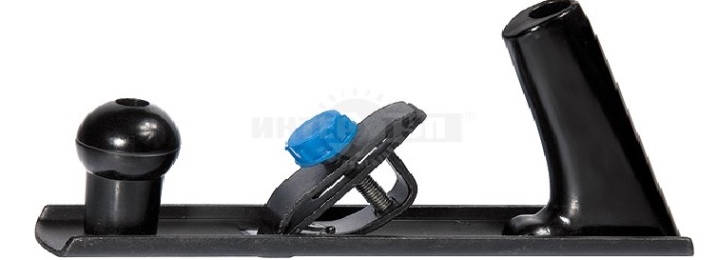
Sparta 210785
The features of the plane include the possibility of extracting excess wood from the surface. Through this processing, it is possible to obtain smooth surfaces even on the smallest details. The body of the tool is made of cast iron, so it does not deform in any way even under heavy working loads.
Advantages:
- availability of a configurable knife centering function;
- use of high quality steel for the blade;
- the presence of a false knife of small sizes.
The latter is used as a chipbreaker, which allows the final processing of the plane of the wooden surface.

"Stankosib 21043"
The planer body is assembled from high quality steel. The manufacturer uses the St3 brand, which ensures resistance to any load and reduces the risk of deformation. The design provides a mechanism that allows you to adjust the cutting angle.
Advantages:
- compact size;
- the ability to handle hard-to-reach places;
- durable knife.
The blade is made of high speed steel... Therefore, it remains sharp for a long time and removes the required layer of wood.

Selection Tips
Choosing a hand plane is a complex and responsible process, which must be approached wisely. Before choosing a tool, it is recommended to carefully study the assortment and pay attention to a number of parameters.
- Sharpening angle. It is the main selection criterion. It determines the quality of wood processing, as well as the speed of work. When choosing a tool, it is also recommended to take into account that its design includes a mechanism that can adjust the sharpening angle.
- Sole. It greatly influences how the result looks. The sole should be smooth. This is the only way to achieve perfect evenness of the treated surface.
- The thickness of the removed shavings. It implies the possibility of changing this indicator. Sharpening planers is not the most convenient option, therefore, it should be provided that manufacturers equip the model with this function.

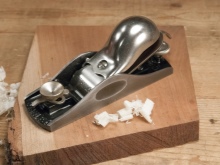














The comment was sent successfully.